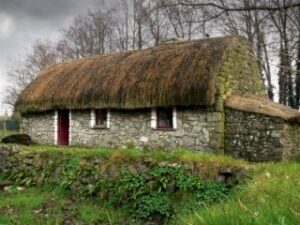Land and property records in Ireland

Irish genealogy researchers working on the first half of the 1800s must rely heavily on property and land records for information. Civil registration wasn’t introduced for everyone until 1864 and all returns from 19th-century censuses have since been lost to us.
Church registers dating back to the 1820s can still be found today and, indeed, many more exist that go further back. Unfortunately for many parishes – two-thirds of Church of Ireland congregations not withstanding – this information doesn’t survive for them during that period.
So many people believe that Irish genealogy resources for the period prior to the middle of the 19th century are scarce.
But there are resources available, like property and land records. While they may be more difficult to access than more obvious options mentioned above, if you are seeking Irish ancestors prior to 1860 then these collections must be explored and understood properly.
This page provides you with an overview of Ireland’s major land and property resources.
Griffith’s Valuation For anyone searching for Irish ancestry pre-civil registration, nothing beats this resource for discovering ancestors pre-civil registration. Officially known as The Primary Valuation of Ireland conducted by Richard Griffith – an Irish geologist born and educated in Dublin – this valuable document is an incredible genealogy treasure chest.
Between 1847 and 1863, he and his group of Valuers traveled throughout the country studying one county at a time.
Griffith published his findings between 1848 and 1864 (download pdf map of Griffith’s Valuation publication dates by county). They were organized according to county, barony, Poor Law Union, civil parish, townland boundaries with assessments for properties within those boundaries; each head of household is also recorded.
Find out more about Griffith’s Valuation and how it could benefit your Irish genealogy research, or study some examples to familiarise yourself with its structure.
Once you are proficient with Primary Valuation of Tenements and ready to pursue more in-depth research, these pages can assist.
Pre-Griffith Townland Valuations and Valuer’s Notebooks; Revision Books/Cancelled Land Books and Current Land Books
Tithe Applotment Books

In 1823, the Church of Ireland revised their system of tithes. A civil parish by civil parish valuation process took 15 years until finally suspended in 1838.
Find out more about Tithe Applotment books and their usefulness to Irish genealogists.
In 1876, The 1876 Landowners List was published. Commissioned by the Local Government Board in 1873, this survey required Poor Law Unions across Ireland to compile lists of landowners from local rate books.
The final return to the Board was filed in November 1872, listing 32,614 owners alphabetically by province and county with details regarding their land areas and current valuations.
Failte Romhat offers free access to their 1876 list.
Estate Records Estate records provide the ideal opportunity for researchers looking for Irish ancestry dating back to the 18th and 17th centuries.
Genealogy researchers often seek information about wealthy families that once owned large tracts of Ireland. Genealogists find them particularly useful, since these families employed large numbers of retainers – domestic staff, farm hands, stone masons and other craftsmen as well as being landlords who granted leases to tenant farmers and labourers.
Estate records can be challenging to locate. Some are still kept within families’ archives; others have been placed with solicitors; an increasing number have been stored with local archives (which may or may not have the resources available to catalogue them); some records simply haven’t survived at all – though when they do exist they can often provide exceptional detail.
Landed Estate Court Rentals Following the Famine, many landowners found themselves financially and morally embarrassed. Congress set up a Court to administer the sale of these insolvent estates in 1848/9; pre-sale catalogues were produced as an inducement to prospective buyers.
These sale particulars contained information on tenants residing on land throughout Ireland, along with details regarding their tenancies or rental commitment. Their genealogical potential is vast as over 500,000 tenants were recorded in this collection.
Find out more about Landed Estates Court Rentals by exploring Republic records online.
Where to Start for Deeds Learn about Irish land divisions such as provinces, townlands and Poor Law Unions.
Irish historical counties – an alphabetical listing
Are You Searching for Irish Ancestry Townlands or Counties?
The Registry of Deeds was first established in Dublin in 1708, though its peak years of popularity were 1750-1830. Though its services cover arrangements other than land transference, its records can provide very helpful evidence as to when land was transferred between parties.
Irish citizens owned no land of such value that it required formal recording; thus this resource will likely not help many family historians. But if your ancestors registered deeds you may find this resource beneficial as such records often mention multiple generations.
Soon I’ll provide more details about the Registry of Deeds.